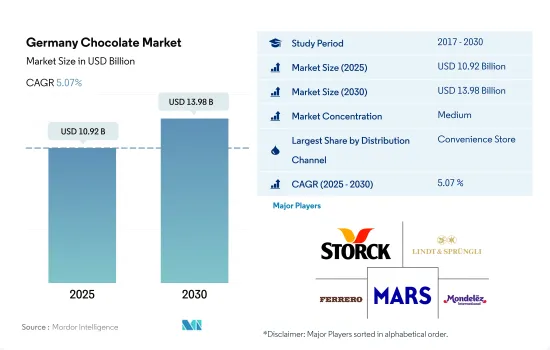Need help finding what you are looking for?
Contact Us
PUBLISHER: Mordor Intelligence | PRODUCT CODE: 1687839

PUBLISHER: Mordor Intelligence | PRODUCT CODE: 1687839
Germany Chocolate - Market Share Analysis, Industry Trends & Statistics, Growth Forecasts (2025 - 2030)
PUBLISHED:
PAGES: 163 Pages
DELIVERY TIME: 2-3 business days
SELECT AN OPTION
The Germany Chocolate Market size is estimated at 10.92 billion USD in 2025, and is expected to reach 13.98 billion USD by 2030, growing at a CAGR of 5.07% during the forecast period (2025-2030).

Convenience stores account for the largest market share, followed by supermarkets and hypermarkets due to rising interest in in-person shopping and demand for discount offers
- In Germany, the overall retailing segment maintained a growth of 4.59% in 2023 compared to 2022. The growth is anticipated to continue with consumers' growing inclination toward convenience shopping facilities in the market. During the forecast period, the overall retailing units in Germany are expected to record a growth of 8.21% by volume. Aspects such as rising interest in in-person shopping and demand for discount offers are likely to drive the retailing industry drastically.
- The convenience store segment was considered the largest retailing unit by volume in 2023. Some of the most famous convenience stores in Germany are Rewe, Spar, and Tegut. By 2026, the convenience store segment in the German chocolate market is estimated to record a growth of 4.48% in its volume share compared to 2024.
- Supermarkets and hypermarkets are the second-largest units in the German chocolate market. These stores have a tendency to offer a wide range of chocolate products with innovative offers to their customers. The sales volume of chocolate products through supermarkets and hypermarkets grew by 4.22% in 2022 and is anticipated to register a CAGR of 19.7% during 2023-2029 in Germany. Chocolate held the largest share of 58.8% among all the confectionery products sold through supermarkets and hypermarkets in 2023.
- Online retailing or e-commerce retailing is considered the fastest-growing retailing segment in the German market. The e-commerce segment registered a CAGR of 5.92% in 2023. The major factor influencing the acceleration of the growth of e-commerce websites is the increasing number of internet users across Germany.
Germany Chocolate Market Trends
Health benefits associated with dark chocolates supported the growing per capita consumption of chocolates in Germany
- Germany is a major chocolate-consuming country as well, registering the largest per capita chocolate consumption in Europe. Germany is the leading producer of chocolate as a consumer product and the largest chocolate consumers in the world are the Germans, with a per capita consumption of 11 kg in 2022.
- More than 80% of all chocolate confectionery sold in Germany in 2022 was made using sustainably produced cocoa. This marks an increase of 76% since 2011 when that share was only around 3%.; The hike was primarily because of the promotion of sustainable cocoa production and sourcing by the German Initiative on Sustainable Cocoa.
- The pricing of chocolates in the country is a significant and influential factor in the consumer's purchasing behavior. Prices may vary, with the average retail price for average chocolate being USD 4 and higher-end chocolates being priced at more than USD 75 in 2022.
- In 2022, more than 55% of consumers in Germany preferred milk chocolate and dark chocolate is expected to be the fastest-growing segment. Consumption of dark chocolate is driven by consumer preferences for healthy products.
Germany Chocolate Industry Overview
The Germany Chocolate Market is moderately consolidated, with the top five companies occupying 57.40%. The major players in this market are August Storck KG, Chocoladefabriken Lindt & Sprungli AG, Ferrero International SA, Mars Incorporated and Mondelez International Inc. (sorted alphabetically).
Additional Benefits:
- The market estimate (ME) sheet in Excel format
- 3 months of analyst support
Product Code: 66445
TABLE OF CONTENTS
1 EXECUTIVE SUMMARY & KEY FINDINGS
2 REPORT OFFERS
3 INTRODUCTION
- 3.1 Study Assumptions & Market Definition
- 3.2 Scope of the Study
- 3.3 Research Methodology
4 KEY INDUSTRY TRENDS
- 4.1 Regulatory Framework
- 4.2 Consumer Buying Behavior
- 4.3 Ingredient Analysis
- 4.4 Value Chain & Distribution Channel Analysis
5 MARKET SEGMENTATION (includes market size in Value in USD and Volume, Forecasts up to 2030 and analysis of growth prospects)
- 5.1 Confectionery Variant
- 5.1.1 Dark Chocolate
- 5.1.2 Milk and White Chocolate
- 5.2 Distribution Channel
- 5.2.1 Convenience Store
- 5.2.2 Online Retail Store
- 5.2.3 Supermarket/Hypermarket
- 5.2.4 Others
6 COMPETITIVE LANDSCAPE
- 6.1 Key Strategic Moves
- 6.2 Market Share Analysis
- 6.3 Company Landscape
- 6.4 Company Profiles
- 6.4.1 Alfred Ritter GmbH & Co. KG
- 6.4.2 August Storck KG
- 6.4.3 Barry Callebaut AG
- 6.4.4 Blanxart Chocolate
- 6.4.5 Chocoladefabriken Lindt & Sprungli AG
- 6.4.6 Duffy's Chocolate
- 6.4.7 Ferrero International SA
- 6.4.8 J. G. Niederegger GmbH & Co. KG
- 6.4.9 Mars Incorporated
- 6.4.10 Mondelez International Inc.
- 6.4.11 Nestle SA
- 6.4.12 Stollwerck GmbH
- 6.4.13 The Hershey Company
- 6.4.14 The KRUGER GROUP
- 6.4.15 Valrhona Chocolate
7 KEY STRATEGIC QUESTIONS FOR CONFECTIONERY CEOS
8 APPENDIX
- 8.1 Global Overview
- 8.1.1 Overview
- 8.1.2 Porter's Five Forces Framework
- 8.1.3 Global Value Chain Analysis
- 8.1.4 Market Dynamics (DROs)
- 8.2 Sources & References
- 8.3 List of Tables & Figures
- 8.4 Primary Insights
- 8.5 Data Pack
- 8.6 Glossary of Terms
Have a question?


SELECT AN OPTION
Have a question?


Questions? Please give us a call or visit the contact form.
